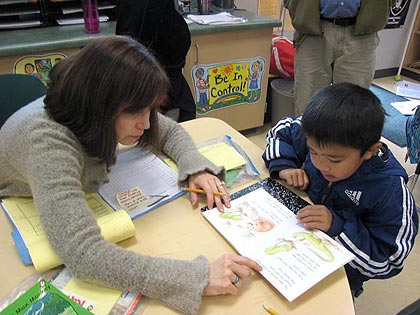
Not all young learners can interpret an expository essay or apply the quadratic equation at the drop of a hat. Unfortunately, some district administrators allow students to “sink or swim” in their learning. But this is not the case with the Santa Clara Unified School District, whose administrators have implemented effective intervention programs to help students struggling in math or reading.
“Five years ago, we didn’t have a coordinated intervention plan,” says Lisa Cesario, assistant superintendent of educational services at SCUSD. “Different sites were doing different things. With the ramp up in accountability, we realized we needed to be more strategic in using our funding. We recognize that [academic] change is a process, and not an event, and it takes time to fully implement quality programs.”
With funds from the YMCA, Enhancing Education Through Technology (EETT), and federal grants offered through the passing of Proposition 49, SCUSD invested in the licensing of ALEKS, a computer program that trains users in math skills. In the four years since SCUSD began using ALEKS, Santa Clara students who have done consistent work on this program have shown visible improvement in their math skills. Though students of all grade levels have access to math intervention programs, ALEKS is intended specifically for students in grades four through 12.
During a seventh and eighth grade math class at Don Callejon School, a California Distinguished School, students requiring additional math practice sit at computers and engage in the lessons the ALEKS program has custom-designed to meet their individual needs.
“The great thing about the ALEKS program is that it can assess the kids’ weaknesses and help them develop stronger math skills,” says Sheldon Piumarta, secondary mathematics curriculum specialist and ALEKS faculty trainer for SCUSD.
Students have also shown remarkable improvement in their reading through the district’s four year-old reading intervention program. In 2009, this program was a recipient of the Hoffman award, a county-wide award recognizing outstanding academic programs.
“Our reading intervention program is currently funded by the American Recovery Act. This was part of Obama’s federal stimulus package,” says Kris Stanga, director of special projects at SCUSD.
“A team, which includes the school principal, the reading intervention specialist, and the classroom teacher, looks at the results of students’ reading assessments to decide who will need services,” says Mary Kay Going, director of curriculum and instruction for SCUSD.
Struggling readers in first and second grade work in groups with a reading intervention specialist. Leanne Thomas is the reading intervention specialist at Don Callejon School. Working with a group in a small semi-circle, she offers each student individual attention.
“Reading should be a normal part of a student’s routine,” Thomas says. “[With reading intervention], many of these kids become successful readers. They are gaining context knowledge because social studies is also embedded into their program. They can read novels at their reading level.”
Struggling readers in middle school and high school participate in a program called Read 180.
“Read 180 has a computer-based component that helps with assessment,” says Going. “This program also involves small group instruction and encourages independent reading at students’ reading level, also known as the Lexile level. The Lexile level is found in many books and ranges from 200 to 1400, depending on one’s grade level. We offer lessons to students on finding the right books for them.”
“These intervention programs are essential,” says Hans Barber, principal of Don Callejon School. “We don’t want to allow students to fall through the cracks.”





